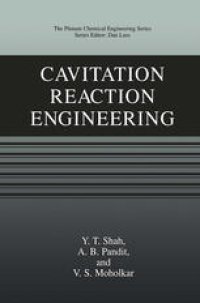
Ebook: Cavitation Reaction Engineering
- Tags: Industrial Chemistry/Chemical Engineering, Atmospheric Protection/Air Quality Control/Air Pollution, Physical Chemistry
- Series: The Plenum Chemical Engineering Series
- Year: 1999
- Publisher: Springer US
- Edition: 1
- Language: English
- pdf
The literature on cavitation chemistry is ripe with conjectures, possibilities, heuris tic arguments, and intelligent guesses. The chemical effects of cavitation have been explained by means of many theories, consisting of empirical constants, adjustable parameters, and the like. The chemists working with cavitation chemistry agree that the phenomenon is very complex and system specific. Mathematicians and physi cists have offered partial solutions to the observed phenomena on the basis of cavitation parameters, whereas chemists have attempted explanations based on the modes of reaction and the detection of intermediate chemical species. Nevertheless, no one has been able to formulate a unified theme, however crude, for its effects on the basis of the known parameters, such as cavitation and transient chemistry involving extremely high temperatures of nanosecond durations. When one surveys the literature on cavitation-assisted reactions, it is clear that the approach so far has been "Edisonian" in nature. While a large number of reactions have showed either enhanced yields or reduced reaction times, many reactions have remained unaffected in the presence of cavitation. The success or failure of cavitation reactions ultimately depends on the collapse of the cavity. Cavitation chemistry is based on the principles of the formation of small transient cavities, their growth and implosion, which produce chemical reactions caused by the generation of extreme pressures and temperatures and a high degree of micro turbulence.
This monograph treats the new and emerging subject of cavitation reaction engineering, specifically, designing the reactor which involves cavitation driven reaction process produced by the hydrodynamic, acoustic or laser forces. The monograph also illustrates the basic treatment of both physics and chemistry associated with the formation, growth and implosion of cavities and the resulting chemical reactions. While a substantial portion of the book reviews the existing literature on cavitation reaction engineering, it also presents some of the authors' views on how to treat the subject from the first principles and what future work is needed to expand knowledge in this area.
While cavitation reaction engineering is immediately applicable to water treatment processes, in the near future this process will be important for many applications in chemical, biochemical, petroleum, pharmaceutical and material industries. Apart from introducing the new and emerging subject of reaction engineering, the book illustrates how an introduction of cavitation process can have added value to many existing chemical, biological and catalytic reaction processes.
The book should be useful to any student, researcher or industrial designer who is interested in designing and scaling-up cavitation reactor.